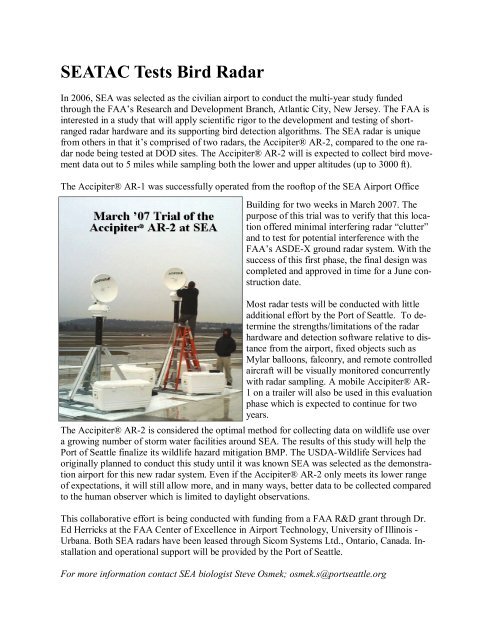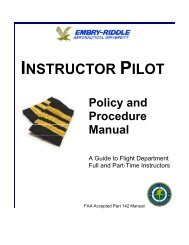Birdstrike test alters B-787 - FAA
Birdstrike test alters B-787 - FAA
Birdstrike test alters B-787 - FAA
You also want an ePaper? Increase the reach of your titles
YUMPU automatically turns print PDFs into web optimized ePapers that Google loves.
SEATAC Tests Bird RadarIn 2006, SEA was selected as the civilian airport to conduct the multi-year study fundedthrough the <strong>FAA</strong>’s Research and Development Branch, Atlantic City, New Jersey. The <strong>FAA</strong> isinterested in a study that will apply scientific rigor to the development and <strong>test</strong>ing of shortrangedradar hardware and its supporting bird detection algorithms. The SEA radar is uniquefrom others in that it’s comprised of two radars, the Accipiter® AR-2, compared to the one radarnode being <strong>test</strong>ed at DOD sites. The Accipiter® AR-2 will is expected to collect bird movementdata out to 5 miles while sampling both the lower and upper altitudes (up to 3000 ft).The Accipiter® AR-1 was successfully operated from the rooftop of the SEA Airport OfficeBuilding for two weeks in March 2007. Thepurpose of this trial was to verify that this locationoffered minimal interfering radar “clutter”and to <strong>test</strong> for potential interference with the<strong>FAA</strong>’s ASDE-X ground radar system. With thesuccess of this first phase, the final design wascompleted and approved in time for a June constructiondate.Most radar <strong>test</strong>s will be conducted with littleadditional effort by the Port of Seattle. To determinethe strengths/limitations of the radarhardware and detection software relative to distancefrom the airport, fixed objects such asMylar balloons, falconry, and remote controlledaircraft will be visually monitored concurrentlywith radar sampling. A mobile Accipiter® AR-1 on a trailer will also be used in this evaluationphase which is expected to continue for twoyears.The Accipiter® AR-2 is considered the optimal method for collecting data on wildlife use overa growing number of storm water facilities around SEA. The results of this study will help thePort of Seattle finalize its wildlife hazard mitigation BMP. The USDA-Wildlife Services hadoriginally planned to conduct this study until it was known SEA was selected as the demonstrationairport for this new radar system. Even if the Accipiter® AR-2 only meets its lower rangeof expectations, it will still allow more, and in many ways, better data to be collected comparedto the human observer which is limited to daylight observations.This collaborative effort is being conducted with funding from a <strong>FAA</strong> R&D grant through Dr.Ed Herricks at the <strong>FAA</strong> Center of Excellence in Airport Technology, University of Illinois -Urbana. Both SEA radars have been leased through Sicom Systems Ltd., Ontario, Canada. Installationand operational support will be provided by the Port of Seattle.For more information contact SEA biologist Steve Osmek; osmek.s@portseattle.org
















